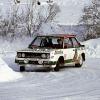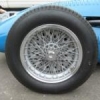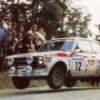Tyrrell P34 - history rewritten
#1

Posted 10 March 2022 - 15:19
To the best of my knowledge the rule change to limit F1 cars to four wheels came in to force in 1981/82.
Advertisement
#2

Posted 10 March 2022 - 15:37
Such twaddle. You are correct. The Tyrrell P34 per se was not banned, or at least - if it was - why was I not informed? ![]()
DCN
#3

Posted 10 March 2022 - 15:48
Would've been embarrassing if I said it raced and won as those naughty ex-Tyrrell employees clearly hoodwinked me!
#4

Posted 10 March 2022 - 16:02
Thought it was banned? Albeit in 1982.
#5

Posted 10 March 2022 - 16:17
Twice this week (the latest being the BBC live text of the preseason F1 testing) I've read statements that the Tyrrell P34 was banned (and soon after its appearance too). Is there some corner if the internet that this has been written and taken up as fact?
To the best of my knowledge the rule change to limit F1 cars to four wheels came in to force in 1981/82.
I wonder if somebody has mixed up the Tyrrell with another imaginatively-designed GP winner of the time, the Brabham BT46 fan car. Curiously they both won their sole victories in Sweden.
#6

Posted 10 March 2022 - 16:20
Why is the P34 getting multiple mentions in this year's F1 testing anyway? Are there some 6 wheelers racing this year?
#7

Posted 10 March 2022 - 16:23
Thought it was banned? Albeit in 1982.
That's like saying the Lotus 79 was banned in 1983 when they mandated flat-bottomed cars!
#8

Posted 10 March 2022 - 17:01
I thought Martin Brundle on SKY was talking about the 6 wheeled Williams. The BBC has almost stopped showing general sport, far too many cooking/dercorating/antique/lifestyle programmes to fit in...
#9

Posted 10 March 2022 - 17:13
I understand that the Beeb's principal concern may be for its audience's mental health...
In many ways one can appreciate their concern. But more pressing current matters should surely occupy us all.
Therefore, by the by and utterly insignificant today, the Tyrrell P34 family definitely reached the end of its frontline career without being banned from Formula 1.
DCN
#10

Posted 10 March 2022 - 17:17
i thought Tyrrell stopped using it due to Goodyear not wanting to produce the front tyres just for this car.....
#11

Posted 10 March 2022 - 19:11
I thought Martin Brundle on SKY was talking about the 6 wheeled Williams. The BBC has almost stopped showing general sport, far too many cooking/dercorating/antique/lifestyle programmes to fit in...
They could do a show about a chef-vet investigating thefts of antiques and that's 60% of the daytime output in one go.
#12

Posted 10 March 2022 - 20:50
Are there some 6 wheelers racing this year?
Careful, you might give them ideas.
#13

Posted 10 March 2022 - 22:56
Well, the Beeb still screens one motor sport programme, sort of - Fast and Farmer-ish on the elusive BBC 3, though the series is now just about finished.
All available on i-player and I reckon great fun, in a big messy tractor, agri-contest sort of way.
#14

Posted 10 March 2022 - 23:09
Originally posted by Dick Dastardly
I thought Tyrrell stopped using it due to Goodyear not wanting to produce the front tyres just for this car.
It was definitely reported at the time that the cars came about only because Goodyear had the surplus capacity to make the special 10" tyres for the car...
So this is the logical conclusion, especially if there was competition on the F1 tyre front looming.
#15

Posted 11 March 2022 - 11:44
Well, the Beeb still screens one motor sport programme, sort of - Fast and Farmer-ish on the elusive BBC 3, though the series is now just about finished.
All available on i-player and I reckon great fun, in a big messy tractor, agri-contest sort of way.
Also on BBC 3 is Gassed Up, a sort of young person's reality social media motoring contest.
But probably not for TNF unless the legendary Blood Pressure thread were to be revived.
#16

Posted 11 March 2022 - 12:21
Also on BBC 3 is Gassed Up, a sort of young person's reality social media motoring contest.
But probably not for TNF unless the legendary Blood Pressure thread were to be revived.
Rumour has it that Blood Pressure did a deal, was given a new identity and lives in a safe house over on the Paddock Club.
https://forums.autos...gears-2nd-gear/
#17

Posted 11 March 2022 - 12:34
i thought Tyrrell stopped using it due to Goodyear not wanting to produce the front tyres just for this car.....
Unfortunately I can't quote a source, but I remember (usual caveats) that Tyrrell abandoned the six wheeler because Goodyear didn't put the same development effort in to the tiny tyres as they did in their conventional ones. Inevitable, really, but maybe only with hindsight.
#18

Posted 11 March 2022 - 13:41
#19

Posted 11 March 2022 - 16:49
They are right though, yet missed a word: "Tyrrell P34 airbox was banned (and soon after its appearance too)."
Hmmm, somewhat early this X-mas quiz.
Advertisement
#20

Posted 11 March 2022 - 18:13
I wonder if somebody has mixed up the Tyrrell with another imaginatively-designed GP winner of the time, the Brabham BT46 fan car. Curiously they both won their sole victories in Sweden.
Nothing to mix up neither the P/34 or BT46B was banned.
Personally I never understood how the BT46B was deemed legal in the first place.
#21

Posted 12 March 2022 - 22:21
You haven't heard Gordon Murray's explanation for the legality of the fan then? I didn't buy it when I heard it at a Goodwood event but some might.
I think DD nailed it in that Goodyear were unwilling to continue developing the front tyres to keep up with developments for the other teams. It is interesting that the other thread suggest that there might have been discussions about fitting the Renault turbo engine which came to nothing but may have contributed to the split with Derek Gardner.
I did see an article once, but cannot remember where, that claimed that the reason for the yellow stripe on the P34 at the launch had been a nod towards discussion that had supposedly already taken place between Tyrrell and Renault for engine supply. Whether those discussions pre-dated the launch or followed later as an attempt to keep the P34 competitive we may never know.
Well, back to the Beeb's assault on my mental health with Nigella doing unspeakable things with unsalted butter and added sea salt on a nightly basis. (Thanks to iplayer)
#22

Posted 13 March 2022 - 11:47
You haven't heard Gordon Murray's explanation for the legality of the fan then? I didn't buy it when I heard it at a Goodwood event but some might.
I think DD nailed it in that Goodyear were unwilling to continue developing the front tyres to keep up with developments for the other teams. It is interesting that the other thread suggest that there might have been discussions about fitting the Renault turbo engine which came to nothing but may have contributed to the split with Derek Gardner.
I did see an article once, but cannot remember where, that claimed that the reason for the yellow stripe on the P34 at the launch had been a nod towards discussion that had supposedly already taken place between Tyrrell and Renault for engine supply. Whether those discussions pre-dated the launch or followed later as an attempt to keep the P34 competitive we may never know.
Well, back to the Beeb's assault on my mental health with Nigella doing unspeakable things with unsalted butter and added sea salt on a nightly basis. (Thanks to iplayer)
Ah but we do!
A bit of the below is from the rough draft of the forthcoming Tyrrell book, the rest from Jabby Crombac's quotes at the time.
When the P34 was first revealed in 1976 there was a yellow stripe on each side. That was because, at time of conception, there was a plan to use the Renault engine. Ken ironically as it would later turn out, persuaded Renault to use a turbocharged engine. The rules had been in place since 1966 to allow a turbo-charged engine but no-one had yet taken the risk as it seemed too costly and hard-work, especially when you had the reliable Cosworth engine.
Jabby Crombac: “Elf paid for Renault’s engines. They wanted to make the step to F1 but didn’t know which engine to go for. They had two plans – one was to add 3 cylinders to the two-litre V6 and make it 3 litre. The other idea was a turbocharged engine because they already had experience of that with the Alpine rally car. So Elf decided Ken should make the choice between the two. He came to Paris in 1975 and listened to both sides. He said that if Renault made 3-litre engine it would never be better than the Cosworth V8, but if they tried something new it would take longer but it might be successful. If it failed, then at least they had tried. So Renault and Elf went for the turbo. But Renault were not in a position – then – to produce a chassis, so the plan was Ken would use the turbo, hence him coming to Paris and hence the yellow stripe”.
Despite what Ken said about risks and time, he didn’t give the project either risk or time. He was never fully convinced about the turbo. He felt vindicated when at the British GP in 1977, Renault – now with their own chassis – made their debut and the turbo engine lasted just sixteen laps. But history would prove Ken wrong.
#24

Posted 14 March 2022 - 09:41
Don't forget that Tyrrell was also working on a fan car to replace the P34.
#25

Posted 14 March 2022 - 11:05
Don't forget that Tyrrell was also working on a fan car to replace the P34.
A six-wheeled twin-chassis fan car, I hope - now that would have been something!
#27

Posted 14 March 2022 - 11:46
A six-wheeled twin-chassis fan car, I hope - now that would have been something!
Six-wheel drive with a Pratt & Whitney turbine? Patrick D would happily drive anything.
#28

Posted 14 March 2022 - 13:19
Ah but we do!
A bit of the below is from the rough draft of the forthcoming Tyrrell book, the rest from Jabby Crombac's quotes at the time.
Wasn’t it Tyrrell that later tried to protest all the other teams on the basis that turbocharging was against the rules? Am I getting mixed up with someone else?
#30

Posted 14 March 2022 - 20:27
Not compared to the Lion...
If Derek Warwick drove a Theodore in European F2 it escaped the attention of Motoring News. Ditto his appearances in Aurora. I was 12,000 miles away at the time but used to read every word in MN, including the ads. I may be getting old but I'm sure I'd remember mention of the Lion and/or Del Boy's exploits in a Theodore. After all "Brave Beltoise Bounces Back for BRM" is the first thing that springs to mind if I'm ever asked for a memorable headline.
#31

Posted 14 March 2022 - 20:46
I remember interviewing David Cox about his Lion project, which I then wrote up for 'Autosport'. I gave him the benefit of the doubt in what I wrote but I can't say I was very impressed by him, nor by his apparently burgeoning self-belief. Dismissing all other contemporary designers as dim-witted was not totally justified. I am afraid I was also somewhat put off by his immensely supportive lady wife, who kept popping up in the doorway repeatedly remarking "He's a winner!"...
I found the entire experience of that visit...well...at least as odd as the Lion concept itself.
DCN
#32

Posted 14 March 2022 - 20:47
Warwick did a season of European F2 in a Theodore in 1979. His best result was a fifth at Mugello. He also raced in Aurora at Mallory, Thruxton and Snetterton in a Theodore. His best result was second at Mallory.If Derek Warwick drove a Theodore in European F2 it escaped the attention of motoring News. Ditto his appearances in Aurora
#33

Posted 14 March 2022 - 20:55
Originally posted by PayasYouRace
Wasn’t it Tyrrell that later tried to protest all the other teams on the basis that turbocharging was against the rules? Am I getting mixed up with someone else?
His contention, if I recall, was that the turbocharger was an engine in itself...
Combustion, he asserted, was taking place and driving the turbine to add to the engine's capacity.
I don't recall whether or not he actually did protest any on this basis.
#34

Posted 14 March 2022 - 21:37
Warwick did a season of European F2 in a Theodore in 1979. His best result was a fifth at Mugello. He also raced in Aurora at Mallory, Thruxton and Snetterton in a Theodore. His best result was second at Mallory.
It was actually a March 792 run by Theodore Racing IIRC.
#35

Posted 14 March 2022 - 22:44
It was actually a March 792 run by Theodore Racing IIRC.
I do remember Warwick racing a March 792. Unless of course it was a Theodore chassis hidden under March bodywork. That would explain the relatively poor results.
#36

Posted 14 March 2022 - 23:05
Thanks Richard, I will look forward to adding that to my bookshelves.
There's a handy gap between a green book with a white 3 on the spine and the lately arrived update of Jenk's Vanwall by Lord Nye of the Strawbales.
If anyone is not in possession of Vanwall, I would recommend getting a shift on. There are few still in the wild. I got my copy from Chater's, which is probably where I got my original edition. It might even have been from the Syon Park shop.
The Lion looks like a dodgy clone of a Jim Bamber production. If only Renault had made use of the "Free power take-off turbine part", turbo lag would have been history so much sooner.
From memory Ken's objection to the turbos was that Ferrari (may be wrong as to which manufacturer used the tweek) were injecting fuel into the exhaust side of the turbocharger. Combustion of this fuel will have expanded the exhaust gases minimising turbo lag at part throttle settings.
Ken's objection was that the volume of the turbocharger constituted an additional combustion chamber and thus should have been added to the 1,500cc of the swept volume of the combustion engine. As a simple minded engineer, it struck me as logical but then Ken was up against Bernie, Ferrari and the rest of the grid.
Bernie and BMW had already won a championship with a rocket fuel that contained levels of toluene and other additives that could never be used in commercial road fuel - the supposed fuel base for the regulated RON limit. It was rumoured that the Brabham fuel sample at Monza had exceeded the RON rating limit, but oddly Nelson got to start from 4th position and kept his race win. Odd that. Ken's adventures with ball bearings seem quaint by comparison.
Ken was also objecting to the ever increasing cost of F1 resulting from adopting turbo engines. Somewhat prescient, but we have gone from building championship winning cars in a wood shed to needing $1billion just to compete.
Hopefully the wood shed can be rescued. I can't see the McLaren Technology Centre ever being transferred to Goodwood for sentimental purposes.
#37

Posted 15 March 2022 - 10:28
Six-wheel drive with a Pratt & Whitney turbine? Patrick D would happily drive anything.
Since you mention components that made fame at indy.....
In the book Grand Prix Story 1976, Austrian author Heinz Pruller also talks about the introduction of the 6-wheeler and Derek Gardner's plans.
But then, He also mentioned that Gardner suggested to Andy Granatelli to built him a 6-wheeler with 4 front wheels but with 4WD by virtue of the rear axle and the middel axle. This car of course for Indy.
Gardner was responsible for the design of the driveline in the 1964 4WD Ferguson P104-Novi.
I have never been able to get the story about this sixwheeler being confirmed or mentioned anywhere else other than in that book, as well for further details about that sixwheeler if it came to engine and/or build-uf of the car. When I even think about how the final result must have looked like, it must have been a monster in size etc.
#38

Posted 15 March 2022 - 10:34
From memory Ken's objection to the turbos was that Ferrari (may be wrong as to which manufacturer used the tweek) were injecting fuel into the exhaust side of the turbocharger. Combustion of this fuel will have expanded the exhaust gases minimising turbo lag at part throttle settings.
Ken's objection was that the volume of the turbocharger constituted an additional combustion chamber and thus should have been added to the 1,500cc of the swept volume of the combustion engine. As a simple minded engineer, it struck me as logical but then Ken was up against Bernie, Ferrari and the rest of the grid.
But then, how was any power from this so called `second engine` transferred onto the driven wheels of the car and thus used in a mnner like the power from the true combustion engine?
#39

Posted 15 March 2022 - 10:54
Exactly. The second-engine "argument" is pretty much Chapman's twin-chassis blather in new clothes. Make a simple thing look complicated, and hope that no one realizes your true intentions!
Advertisement
#40

Posted 15 March 2022 - 11:39
But then, how was any power from this so called `second engine` transferred onto the driven wheels of the car and thus used in a mnner like the power from the true combustion engine?
An internal combustion engine works by burning fuel in a combustion chamber which causes air to expand rapidly, pushing down the piston which converts into crankshaft power.
If fuel is burnt in a turbocharger, more pressure is created in the compressor part of the turbocharger, increasing air flow rate -- which in turn increases crankshaft power via the ICE.
Unless an ICE runs extremely fuel lean, there is always fuel in the exhaust which drives the turbine part of the turbocharger. Fair enough, I suppose. However, once the engine designer intentionally runs the engine fuel rich, guaranteeing that burn takes place in the turbine and exhaust pipes, the engine has acquired an extra combustion chamber.
#41

Posted 15 March 2022 - 12:43
An internal combustion engine works by burning fuel in a combustion chamber which causes air to expand rapidly, pushing down the piston which converts into crankshaft power.
If fuel is burnt in a turbocharger, more pressure is created in the compressor part of the turbocharger, increasing air flow rate -- which in turn increases crankshaft power via the ICE.
Unless an ICE runs extremely fuel lean, there is always fuel in the exhaust which drives the turbine part of the turbocharger. Fair enough, I suppose. However, once the engine designer intentionally runs the engine fuel rich, guaranteeing that burn takes place in the turbine and exhaust pipes, the engine has acquired an extra combustion chamber.
Fair enough. I am a massive fan of turbocharging technology, (just about any kind of turbocharged engine over whatever atmospheric multicylinder at insane rpm levels so to speak)
so all of your explanations make sense to me and really ain't new.
But for me, an engine is only an engine if the power it generates is supplied directly onto the driven wheels and in that manner is converted into traction and/or speed.
I could add something more to all of this. But given some fierce debates with certain other posters over here I shall keep the lid on the pot over here. We're talking primarily about one of the most innovative F1 cars ever, one that I also admire and respect for its originality as well as the thinking behind it. It was a brilliant thought and it deserved better results than it eventually achieved.
Edited by Henri Greuter, 15 March 2022 - 13:08.
#42

Posted 15 March 2022 - 18:26
Since you mention components that made fame at indy.....
In the book Grand Prix Story 1976, Austrian author Heinz Pruller also talks about the introduction of the 6-wheeler and Derek Gardner's plans.
But then, He also mentioned that Gardner suggested to Andy Granatelli to built him a 6-wheeler with 4 front wheels but with 4WD by virtue of the rear axle and the middel axle. This car of course for Indy.
Gardner was responsible for the design of the driveline in the 1964 4WD Ferguson P104-Novi.
I have never been able to get the story about this sixwheeler being confirmed or mentioned anywhere else other than in that book, as well for further details about that sixwheeler if it came to engine and/or build-uf of the car. When I even think about how the final result must have looked like, it must have been a monster in size etc.
See here, quoted from an interview with Derek Gardner by Nigel Roebuck in Autosport:
https://forums.autos...78-tyrrell-p34/
“Although the P34 was drawn up in 1975, the idea had come to Gardner some years earlier. When first the car appeared, the immediate assumption of most was that the primary aim of four tiny front wheels was to reduce the frontal area, in the interests of straightline speed. Not so, Gardner said.
"No, the starting point had not been the tiny front wheels. The concept really went back to the 1968 Indy Lotus turbine car, on which I was responsible for the four-wheel drive."
By the end of that year, Gardner had come up a design for a six-wheeled Indy car, with two of the four front wheels being driven, plus the two at the rear. Lotus were now gone from Indianapolis, so Derek put a proposal to Andy Granatelli, whose STP company had sponsored the turbine cars, but it came to nothing, and he simply filed the idea away.”
#43

Posted 15 March 2022 - 20:41
See here, quoted from an interview with Derek Gardner by Nigel Roebuck in Autosport:
https://forums.autos...78-tyrrell-p34/
“Although the P34 was drawn up in 1975, the idea had come to Gardner some years earlier. When first the car appeared, the immediate assumption of most was that the primary aim of four tiny front wheels was to reduce the frontal area, in the interests of straightline speed. Not so, Gardner said.
"No, the starting point had not been the tiny front wheels. The concept really went back to the 1968 Indy Lotus turbine car, on which I was responsible for the four-wheel drive."
By the end of that year, Gardner had come up a design for a six-wheeled Indy car, with two of the four front wheels being driven, plus the two at the rear. Lotus were now gone from Indianapolis, so Derek put a proposal to Andy Granatelli, whose STP company had sponsored the turbine cars, but it came to nothing, and he simply filed the idea away.”
Thank you Sir ....
Thank you Sir ....
Thank you.
#44

Posted 19 March 2022 - 21:28
An internal combustion engine works by burning fuel in a combustion chamber which causes air to expand rapidly, pushing down the piston which converts into crankshaft power.
If fuel is burnt in a turbocharger, more pressure is created in the compressor part of the turbocharger, increasing air flow rate -- which in turn increases crankshaft power via the ICE.
Unless an ICE runs extremely fuel lean, there is always fuel in the exhaust which drives the turbine part of the turbocharger. Fair enough, I suppose. However, once the engine designer intentionally runs the engine fuel rich, guaranteeing that burn takes place in the turbine and exhaust pipes, the engine has acquired an extra combustion chamber.
IIRC Ferrari went so far as to deliberately ignite the exhaust gases ahead of the turbo either by injecting fuel and or using a spark when the accelerator was not pressed on their 126CK in 1981 to reduce turbo lag, not sure they were ever allowed to race like that.
#45

Posted 22 March 2022 - 11:09
IIRC Ferrari went so far as to deliberately ignite the exhaust gases ahead of the turbo either by injecting fuel and or using a spark when the accelerator was not pressed on their 126CK in 1981 to reduce turbo lag, not sure they were ever allowed to race like that.
But even then, the idea wasn't new in 1981:
There has been talk about such a device being developed for whatever turbocharged ferrari engine would be used in the early '70s if the cover of "Uncle Franco" had not been blown in 1971.
FerrariStory magazine published such in a 1996 article about that adventure.
#46

Posted 22 March 2022 - 16:42
I think the tenuous theoretical argument goes something like this:
If you run a turbocharged engine up to its working temperature and switch off the ignition, it will keep running after a fashion. The unburnt petrol air mixture will continue to burn in the hot turbine keeping it rotating. The turbine will keep the compressor going. The compressed air will continue to push the pistons turning the engine over. Hence a turbocharger is a supplementary motor.
Well, I did say tenuous theoretical"
#47

Posted 22 March 2022 - 20:21
I think the tenuous theoretical argument goes something like this:
If you run a turbocharged engine up to its working temperature and switch off the ignition, it will keep running after a fashion. The unburnt petrol air mixture will continue to burn in the hot turbine keeping it rotating. The turbine will keep the compressor going. The compressed air will continue to push the pistons turning the engine over. Hence a turbocharger is a supplementary motor.
Well, I did say tenuous theoretical"
Stupid question by me I suppose.
But if an engine is at the working temperature and ignition is switched off, how long will combustion still take place in order to provide exhaust gasses to keep the turbo and thus the engine running as you suggest?
Besides that, the process of self ignition as you described had been a terminal problem for the early generation of turbocharged engines, if F1 only cured once they adopted the toluene based brews that had an octane rating while containing little to no octane to begin with any longer!
Edited by Henri Greuter, 22 March 2022 - 21:08.
#48

Posted 22 March 2022 - 20:33
Combustion will stop, but Duncan was suggesting that unburnt gases will ignite in the hot turbine, which is fair enough. For how long? Probably as long as the inertia of the crankshaft movement is big enough to overcome friction of pistons, bearings etc, so if the transmission is declutched it may continue to run for several seconds...
#49

Posted 24 March 2022 - 09:23
There are numerous videos on youtube of people turning turbochargers into jet engines by simply adding a combustion chamber and a fuel supply.
#50

Posted 24 March 2022 - 14:06
Can't help remembering the (no doubt) apocryphal story of the bloke deciding to remove the gunge at the bottom of his car's fuel tank by using his wife's cylinder vacuum cleaner. Inserted hose through the filler neck, plugged in and switched on. Fuel vapour met spark from electric motor, large tongue of flame erupted from the vacuum's outlet hole and machine, now jet propelled, took off. Only stopped when plug came out of the power socket and/or hose came out of the filler neck, by which time car and wooden garage were well alight. One of those 'seemed a good idea at the time' moments.






























